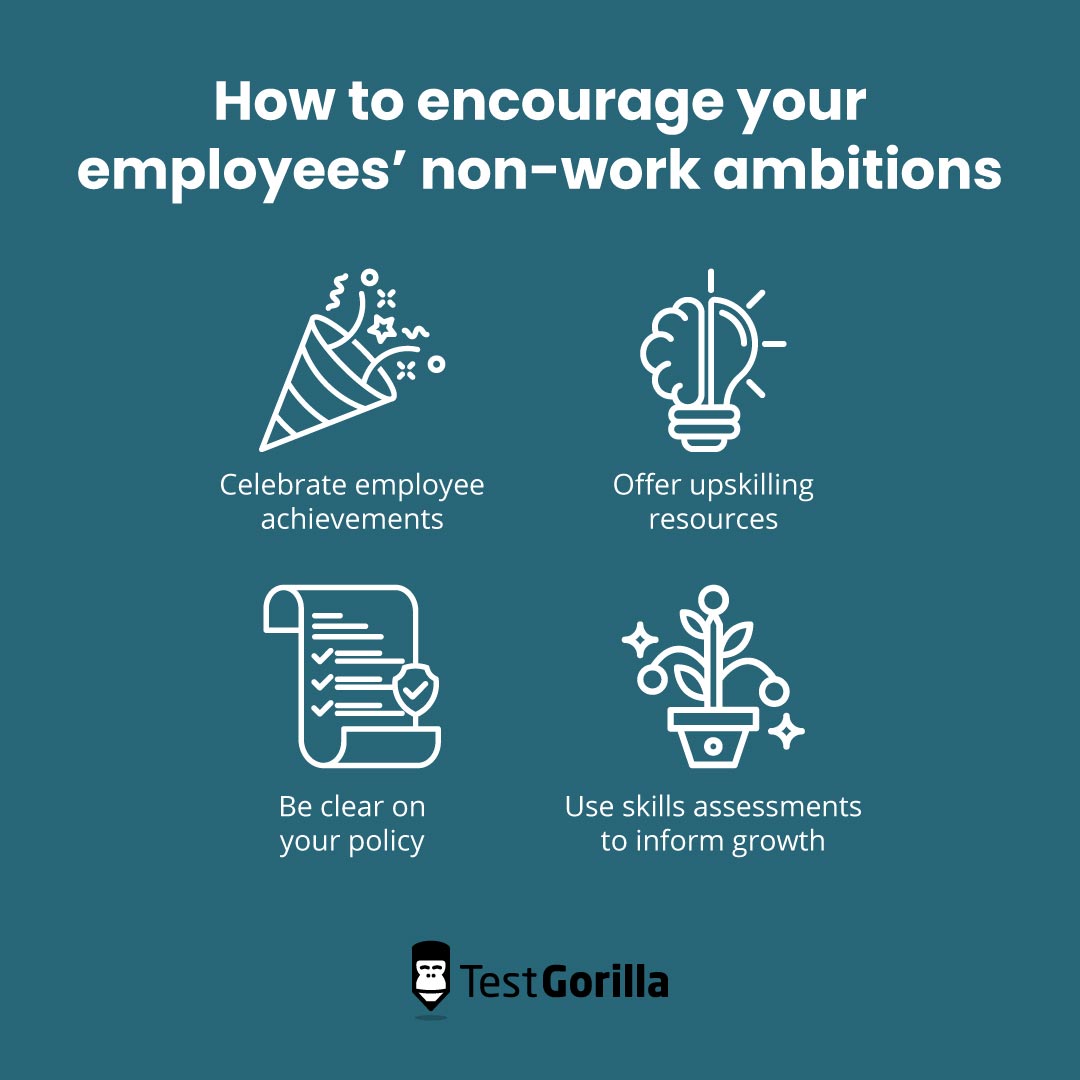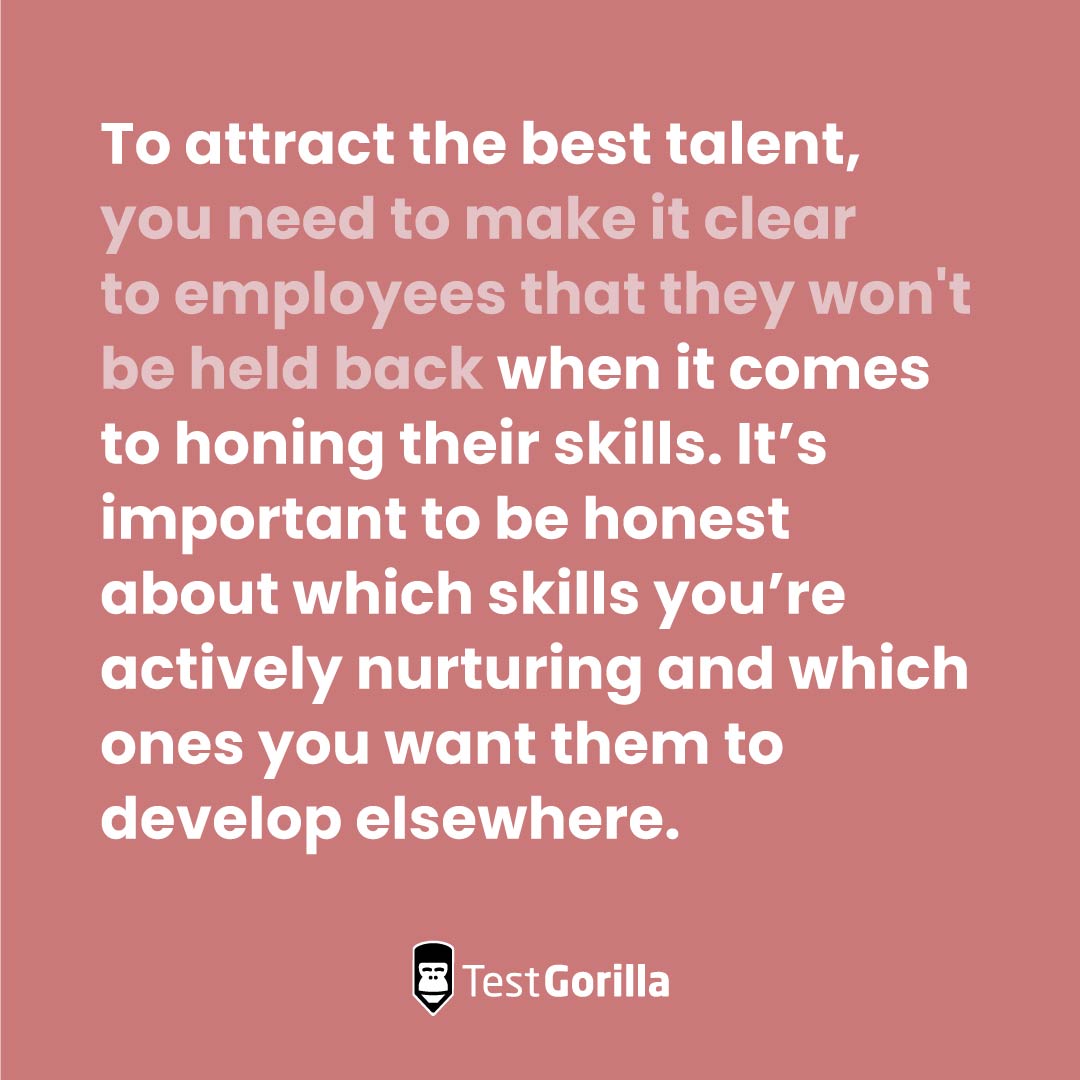Plenty of people, particularly Gen Zs, have side hustles. In fact, 70% of Gen Z plan to pursue one in the coming year.¹ This is partly to earn extra cash, but also to ensure they have a wide range of skills to set themselves up for future employment and career pivots.
Side hustles aren’t just a result of a booming gig economy and young people prioritizing career mobility. They’re also an indicator of the many amazing skills and interests your employees have outside of work. By engaging and developing workers, you can show your support for their side projects and help them grow both personally and professionally.
To get the best talent for your open positions, it’s important to support your people — including their professional and personal aspirations. Research shows that side hustles can actually increase employee productivity because the extra outlet brings a sense of fulfillment and empowerment.² And who knows – maybe your employees have hidden talents that could be valuable in the workplace, too.
In this piece, we’ll look at why employers should support workers’ side hustles rather than discourage them. We’ll also examine how skills-based testing can help you discover and develop employees’ wider skill sets, leading to improved job satisfaction and worker retention.
Table of contents
✅ Help your teams reach their potential with skills-based hiring
Living in the age of the side hustle
A side hustle, otherwise known as a side job or gig, is when you take on a second job separate from your day job or full-time job, as an additional source of income and skills development. For Gen Z, this might look like being an influencer on social media or a freelance content creator. For Millennials, it might involve selling crafty items on Etsy or starting a podcast.
No matter what the side hustle is, it’s important to encourage it and help make every employee’s broader work experience unique and exciting.
You might think side hustles can spread an employee’s time or attention too thin, therefore interfering with job output and performance. However, people are more likely to perform well in their full-time job when they’re supported and encouraged to explore their passions, interests, and aspirations.²
Side hustles also allow your team to grow their skill set in unique directions which might become useful on the job. For example, they can gain merchandising experience by running a small e-commerce store. Encouraging a wide range of skills can also improve horizontal and vertical career mobility, and make it easier to reskill and upskill employees.
6 reasons to embrace your employees’ side projects
We spoke to leadership coach and CEO advisor Bill Catlette about how leaders can support side hustles, and why it’s important for them to do so:
“Today, American business hires and fires tactically, to suit quarterly earnings cycles. In too many cases, aside from tuition aid provided by mainly larger corporations, worker development is a DIY proposition. That brings about a mindset change in the individual: If I’ve got to provide for my own learning and development, then I’ll invest that talent and knowledge where it’s doing me the most good.”
Bill Catlette, founder and managing partner of Contented Cow Partners
In other words: people will invest their time in who and what invests in them. This means leaders should take it upon themselves to create an environment that encourages continuous learning and skills development. Otherwise, employees might look elsewhere for a management style that better suits their specific needs and working arrangements.
Here are some other reasons employers should embrace employees’ side hustles.
1. Employee happiness
While speaking on a recent episode of the Wall Street Journal’s As We Work podcast, assistant professor at Arizona State University Hudson Sessions said side hustles can make people better at their day jobs.
According to Sessions: “[Side hustles] can have these positive, enriching experiences that carry forward into their full-time work.” He then goes on to say that when people pursue things that make them feel good about themselves, it can have an “impact that can’t be underestimated.”³
By being an additional source of fulfillment, side hustles can improve employee happiness and boost morale during and outside work. Sessions also found that “performance enrichment from side hustles is stronger than performance conflict.”
2. Professional development
Across the workforce, but particularly among Gen Zs, employees are hungry for growth opportunities. However, 56% of employees say there aren’t enough growth opportunities in their company to make them want to stay long-term.¹ Additionally, 55% believe the best way for them to develop their skills is to change companies.¹
By supporting your people’s side hustles, you can help them develop their competencies and work alongside them to forge a career path based on their interests and desired skills.
This shows your team you care about growth at the company level and at the individual level. You can also help employees carve out a new position that better combines their new and applied skill set — and keep them invested in the company and interested in their role.
3. Innovation
Diversity of thought and experience leads to innovation — and according to McKinsey & Company’s Diversity wins report, diverse teams are more likely to financially outperform non-diverse ones. Side hustles can make your workplace more innovative and dynamic by inviting a variety of perspectives and approaches. This cross-pollination of ideas can also help bring innovative solutions and fresh insights to your core job.
For example, being a teacher or instructor on the side might help develop client-facing relationship skills in the workplace. Additionally, being a freelance photographer or video editor could improve online marketing skills and digital asset creation.
When you value people’s creativity, they bring their range of skills to the table without feeling like they need to hide their side hustle. Most side hustles require a mix of soft and hard skills, like communication skills mixed with Photoshop skills, or active listening skills combined with social media skills. This can help to create a well-rounded employee with a lot to offer.
Pro tip: Use skills-based hiring to recruit more diverse teams from a wider talent pool by focusing on their skills and not their resumes or degrees. Then, keep testing their skills for an up-to-date understanding of how to best support and grow with your team.
4. New connections
Employees with side hustles are more likely to expand their network and develop professional relationships that can help the core business.
Side hustles involve acquiring new skills or honing existing ones. As they develop these skills, people might seek out mentors, collaborators, or industry experts who can guide them along the way. These connections can become valuable sources of knowledge for an employee because they might offer expertise that aligns with the employee’s wider professional goals.
By making connections and leveraging them, people improve their ability to form and nurture strong professional relationships. To support team members in building new contacts, encourage them to attend industry events, join online communities, and engage in conversations related to both their side hustle and their core job.
5. Better work-life balance
When employees have side projects, they’re less likely to risk burnout from a 10-12-hour working day in their main job. They’re also more likely to put their foot down when they get stressed or overallocated work — which is better for their health and for the company culture as a whole.
Although having more than one job at a time might seem counterintuitive when it comes to work-life balance, side hustles let team members pursue interests and skills they don’t normally get at their day job.
This leads to a sense of fulfillment that helps improve work-life balance and inspires a culture of curiosity and growth at work. When people feel supported in the workplace and not on the verge of burnout, you get engaged employees who are ready to show up and do their best work.
6. Employee empowerment
By openly accepting employees’ side projects, you show them that you trust them to have a professional life outside of work — and split their time effectively.
You’re also demonstrating that you prioritize skills development and empowering employees to expand their horizons. It’s important to recognize that people might want opportunities beyond promotion – for example, the opportunity to broaden their skills – and if they’re supported by their employer while doing it, the better. No one wants to feel like they have to keep their side hustle a secret.
“Out of understandable self-interest and security, in many cases, the American worker has reprioritized the job (gig) ahead of the employer,” says Bill. “But, as my son once put it: “I didn’t marry this job. We’re just dating, and not even exclusively!”
4 ways to encourage your employees’ side hustles
By nurturing employee’s external achievements you show them you support them, which will improve their engagement at work and increase their ability to find meaning in their work.⁴
Here’s how you can encourage your employees’ ambitions outside the office to retain them and help them find happiness at work.
1. Celebrate employee achievements
To demonstrate to employees that you have a work culture that supports side hustles and an entrepreneurial mindset, it’s important to highlight employee accomplishments outside of work. For example, celebrating an employee’s new skill or interest on social media and your internal Slack channel.
You can also spotlight employees in your monthly newsletter and ask them to share a story of when their new skill helped them do better at their core job, or approach a situation with a new perspective. This might inspire other employees to pursue side hustles that align with their interests while supplementing their income.
2. Offer upskilling resources
Offer and encourage upskilling resources to keep employees engaged and thriving at work. This is especially important since 68% of employees and 77% of business leaders say they would rather make a lateral move that offers new skills over a vertical move that is more senior but has fewer skills development opportunities.¹
Provide the right upskilling resources by understanding when employees are ready to take their skills to the next level, and where they need support. Here are three simple steps you can take:
Use skills tests to assess your employee’s current skills and perform a Strengths, Weaknesses, Opportunities, and Threats (SWOT) analysis. For example, you could test employees on negotiation skills, problem-solving skills, or computer programming and coding skills.
Create a skills ranking system where you rate specific skills from 1-10.
Go over the results with individual team members and figure out how you want to address the skills gaps, together.
“Truth be known, the causal factor in many workplace separations is not the work or the opportunity, but people simply growing tired of working for an unskilled or uncaring leader. Sincere and dedicated effort to upskill the management team is one of the best investments employers can make.”
Bill Catlette, founder and managing partner of Contented Cow Partners
Pro tip: Prioritize internal mobility and encourage employees to view their career as a playground or rock climbing wall, rather than a traditional ladder.
3. Be clear on your policy
While you probably don’t want your programmers working as programmers for anyone else (and should cover this in an exclusivity clause), you’re less likely to mind if they’re making some extra cash as a TikTok influencer or Airbnb host.
It’s important to be clear about your work policy and desired time commitment from the beginning of the recruitment process. According to Bill, this means, “Baking [your expectations] into the organization’s recruitment, selection, and learning & development methodology and management performance measures.”
It’s also about “finding out on the front end what people want to do with their lives, and realistically evaluating any possible link between the interests of the prospective teammate and the organization. Be especially clear about employment expectations (both ways). If the match isn’t quite right, keep looking!”
4. Use skills assessments to inform growth
Side hustles give people an opportunity to learn new skills and hone existing ones. However, to truly benefit from a side project, it’s important you first need to determine where your strong suits lie, and which skills need developing further.
Talent assessment software can help you pinpoint employee skill sets with skills-based tests and assignments. You can test a range of hard, soft, and transferable skills – from Technical SEO to communication skills – and quickly spot skills gaps and areas for growth.
Skills-based tests like our culture-add test also demonstrate an employee’s ability to add to company culture, which will likely improve when they have a side job that brings them a new perspective. Testing for skills helps team members map out their existing and desired skills profile, as well as potential side hustles they could pursue — and creates more targeted growth opportunities.
Pro tip: To find out more about where a candidate’s interests and skills lie, use talent assessment software to create customized skills-based tests. Use them to better understand potential candidate-job alignment before you start interviewing.
Not just a hustle, but hands-on skills development
To attract the best talent, you need to make it clear to employees that they won’t be held back when it comes to honing their skills. It’s important to be honest about which skills you’re actively nurturing and which ones you want them to develop elsewhere.
By investing in your people inside and outside your organization, you can foster purpose-driven teams who enjoy what they do. Additionally, you get a diversity of experiences and skills that can improve the quality and outcomes of projects at work.
In this piece, we looked at the growing trend for workers to pursue side projects and why employers should embrace them. By celebrating their achievements, using upskilling resources, and being clear on your policy, you can encourage your team and their non-work ambitions.
Additionally, when you use skills-based assessments during and after hiring, you can better understand your staff’s strengths and weaknesses — and how they can put their skills to good use to improve job satisfaction.
Want to help your teams reach their potential in and out of work? Skills-based talent assessments let you spot any skills gaps — so you know where to improve. Check out our extensive test library.
Sources:
“Work Trend Index Report: Hybrid Work is Just Work, What Are We Doing Wrong?” (2O22). Microsoft. Retrieved on May 29, 2023. https://www.microsoft.com/en-us/worklab/work-trend-index/hybrid-work-is-just-work
“Do the Hustle! Empowerment from Side-Hustles and Its Effects on Full-Time Work Performance.” (2021). Academy of Management Journal. Retrieved on May 29, 2023. https://journals.aom.org/doi/abs/10.5465/amj.2018.0164
“Why Your Side Hustle May Actually Be Good for Your Main Job.” (2023). Wall Street Journal Podcasts. Retrieved on May 29, 2023. https://www.wsj.com/podcasts/as-we-work/why-your-side-hustle-may-actually-be-good-for-your-main-job/66a5bbe7-60cf-4158-bc7d-2f823c0a582e
“State of the Global Workplace: 2022 Report.” (2022). Gallup. Retrieved on May 29, 2023. https://www.gallup.com/workplace/349484/state-of-the-global-workplace.aspx
Related posts
Hire the best candidates with TestGorilla
Create pre-employment assessments in minutes to screen candidates, save time, and hire the best talent.
Latest posts
The best advice in pre-employment testing, in your inbox.
No spam. Unsubscribe at any time.

Hire the best. No bias. No stress.
Our screening tests identify the best candidates and make your hiring decisions faster, easier, and bias-free.
Free resources
This checklist covers key features you should look for when choosing a skills testing platform
This resource will help you develop an onboarding checklist for new hires.
How to assess your candidates' attention to detail.
Learn how to get human resources certified through HRCI or SHRM.
Learn how you can improve the level of talent at your company.
Learn how CapitalT reduced hiring bias with online skills assessments.
Learn how to make the resume process more efficient and more effective.
Improve your hiring strategy with these 7 critical recruitment metrics.
Learn how Sukhi decreased time spent reviewing resumes by 83%!
Hire more efficiently with these hacks that 99% of recruiters aren't using.
Make a business case for diversity and inclusion initiatives with this data.






















